Ligue 2 side Valenciennes were one of the sides with interesting numbers in the 2019/20 season. They are one of the lowest-scoring team in the league with only 24 goals scored from 28 matches but they have accumulated a pretty decent amount of 30.86 xG which may indicate that they’re not lacking the ability to get the ball into good goalscoring positions and create chances, but rather lacking clinicality in front of goal. What’s more interesting is that they have the fourth-highest xG allowed in the league this season with 39.63, but they’re also the team with the least goals conceded this season, allowing only 20 goals.
In this team scout report, we’re going to take a look at Valenciennes’ defensive tactics through tactical analysis and a bit of statistical analysis to see how they manage to concede so few goals this season. Is their defence really that solid or are they just incredibly lucky throughout the season? Or perhaps the goalkeeper is doing all the work for them? We’ll find out in the analysis below.
Overview
Olivier Guégan mainly deploys his team in a 3-5-2 formation, although sometimes they field a 3-4-3, 3-4-2-1, or 3-4-1-2 formation. Back-three formations are what Guégan prefers, although on some occasions they can also be seen using a few variations of back-four formations such as 4-1-4-1, 4-4-2, 4-1-3-2, as well as, 4-2-3-1.
In the 3-5-2 formation, the team operate with three centre-backs, two conventional wing-backs, one defensive midfielder, two central midfielders, and two strikers. They tend to have the two wing-backs drop back when out of possession, creating a 5-3-2 formation. The same also applies with other variants of back-three that they use (3-4-3 and 3-4-2-1 become 5-4-1 in defence while 3-4-1-2 become 5-2-1-2).
Jérôme Prior is the mainstay in the goalkeeping spot. In front of him, Emmanuel Ntim, Maxime Spano, and Joffrey Cuffaut have been the main choices as a right, middle, and left centre-back respectively. Wing-backs Laurent Dos Santos and Lilian Brassier (on loan from Ligue 1 side Rennes) are Guégan’s first choices in the right and left wing respectively. Former Barnsley and PSG man Sessi D’Almeida usually occupies the defensive midfielder berth while Julien Masson and Metz loanee Gauthier Hein play as the central midfielders. The two main strikers upfront are Teddy Chevalier and Malek Chergui.
Valenciennes seem to use a mix of space-oriented and man-oriented approach in defence. Unlike Atalanta, for example, who are very in their defensive shape, Valenciennes aren’t very flexible. They tend to maintain their five-man backline rather than adapt to the opposing team’s shape in the build-up.
Valenciennes are not really a team that are very aggressive and intense in pressing. They have an average of 11.54 PPDA per game this season which puts them in 12th place when it comes to PPDA ranking in Wyscout. They also record an average of 5.7 defensive actions per minute of opponent possession which puts them in 11th place in Wyscout rankings when it comes to challenge intensity. They don’t press high up the pitch but rather tend to block off the opposition’s access towards certain areas and force them into playing the ball through a certain area where they will trigger their pressing trap and win back possession.
Minimal pressure in the attacking third and block access to central areas
Guégan’s side tend to defend with a mid-block. Instead of pushing players up the field and pressing high, Valenciennes tend to allow the opposing team to play from the back with minimal pressure and allow the opposing backline to move higher up the pitch and further from their penalty area. They’ll defend with a compact mid-block with the first and second line of defence being very narrow whilst the defensive line maintains their width. Unlike high-pressing teams who would look to prevent the opposing team to build up from the back and force them to play long, Valenciennes’ main goal is to prevent central progression and force the opposing team to move the ball through the flank where Valenciennes would be able to trap and press them.
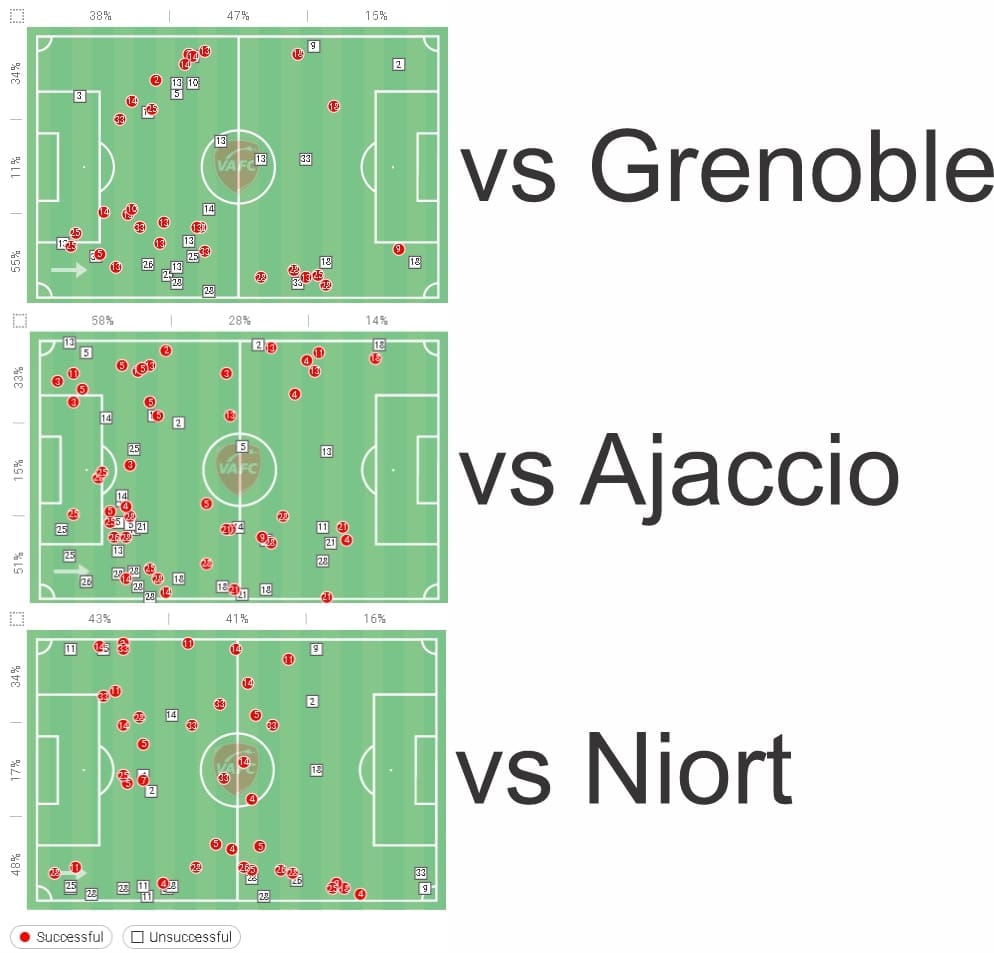
This is why, as you can see above, there are a lot more defensive activities in wider areas as well as wide channels rather than in the middle. As you can also see, the majority of their defensive activities are also inside the middle third and defensive third rather than the attacking third. Let’s take a look at their structure below.
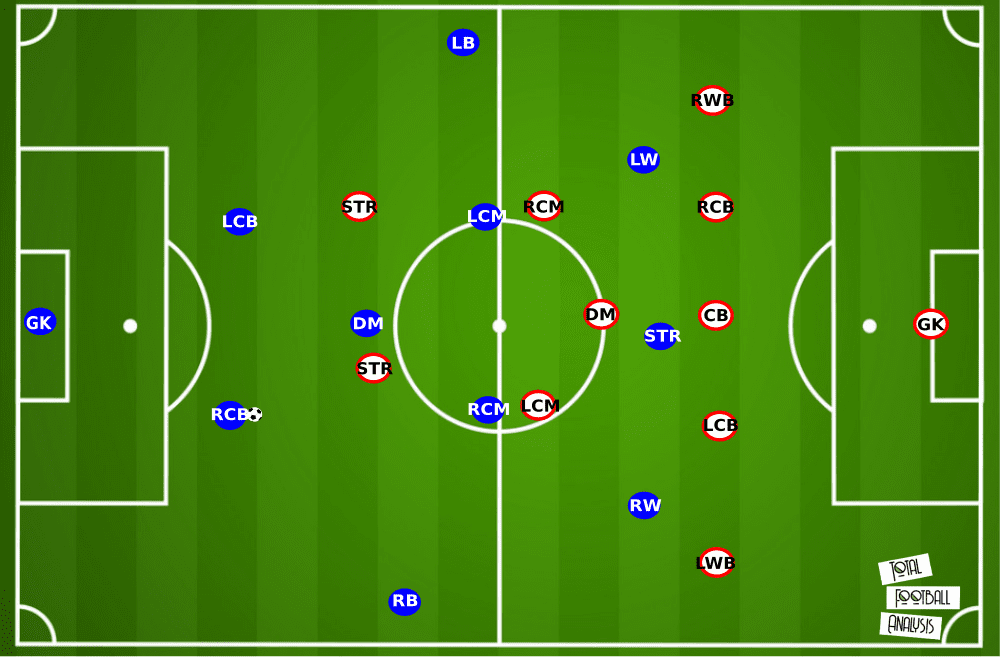
Above you can see their shape in defence. As mentioned earlier in this analysis, Valenciennes look to use a mix of man and space-oriented approach in defence. The two strikers upfront tend to sit back and try to block access to central midfielders. One of them will also look to mark the opposing defensive midfielder.
Meanwhile, the two central midfielders are man-oriented and will look to mark the opposing central midfielders. In this particular situation, the defensive midfielder is free from man-marking duty so he’ll mainly move laterally and protect the space between defence and midfield. However, he will man-mark an opposing player if that player enters his “zone”.
The wing-backs, as you can see, tend to sit deep and accompany the three centre-backs whilst also tasked to man-mark the opposing wingers. The two wing-backs tend to actively follow their man and step out of their position while the nearby right/left-sided centre-back will move closer to the flank and cover the space the wing-back left. This can be seen in the image below.
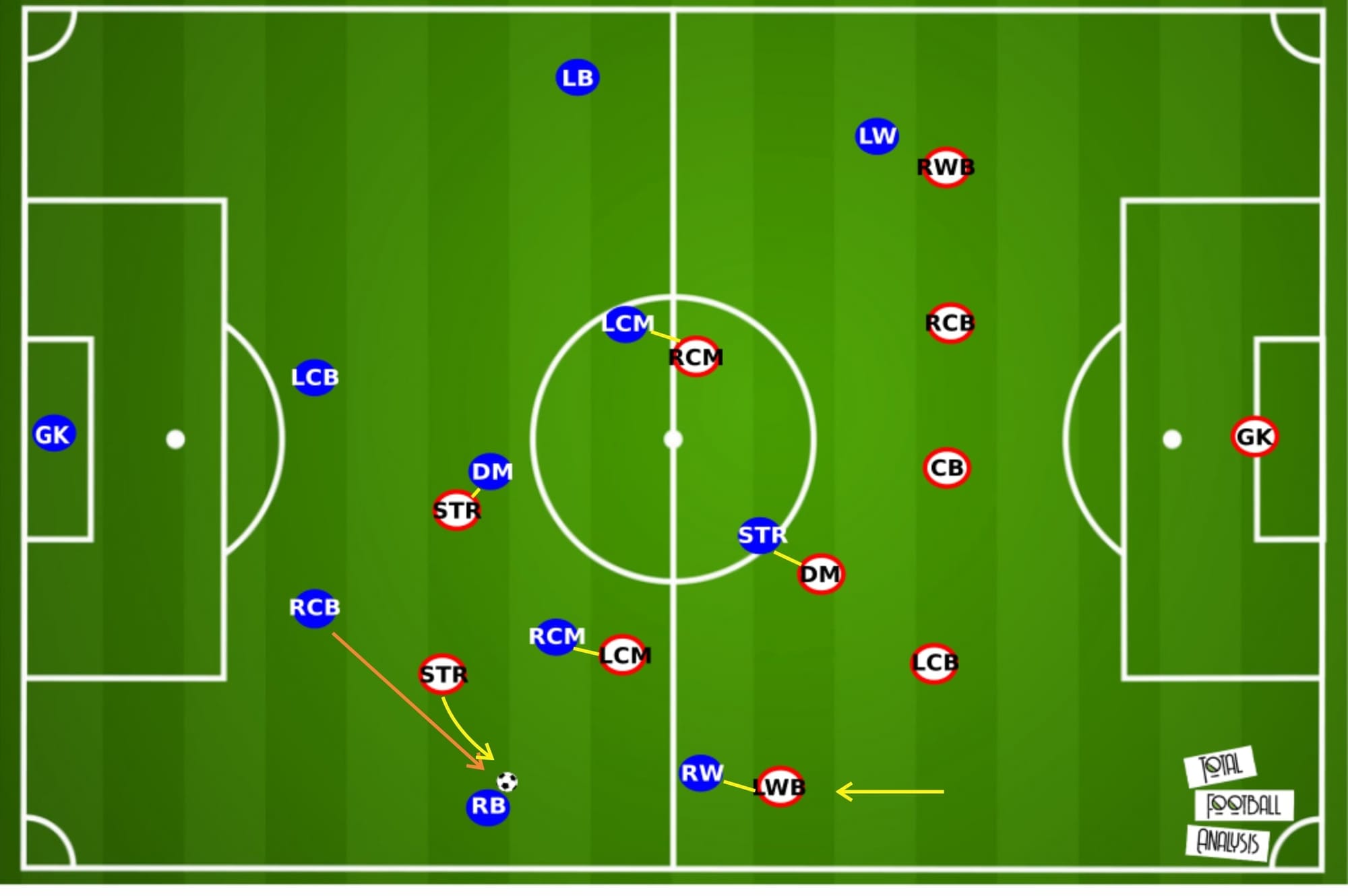
As you can see above, with access to central areas blocked and central options marked, the opposing right centre-back passed the ball towards the right-back. Valenciennes immediately move their block to overload the area and isolate the ball carrier by man-marking the nearby options whilst simultaneously compressing the space and giving him pressure. Above you can see the left wing-back of Valenciennes pushed forward and stayed close to his man while the left centre-back moved to cover his space.
The ball-near Valenciennes striker will close down the ball carrier on the flank while making a curved run in order put the opposing right centre-back in his cover shadow and block the passing lane towards him. Meanwhile, the other striker marks the opposing defensive midfielder.
You can also see in the picture that the opposing striker dropped from his position to offer support in the middle third. The centre-backs usually don’t man-mark very tightly and will leave their man if they move out of their zone. In the situation above, the opposing striker enters the defensive midfielder’s zone and the defensive midfielder will then start marking him man for man.
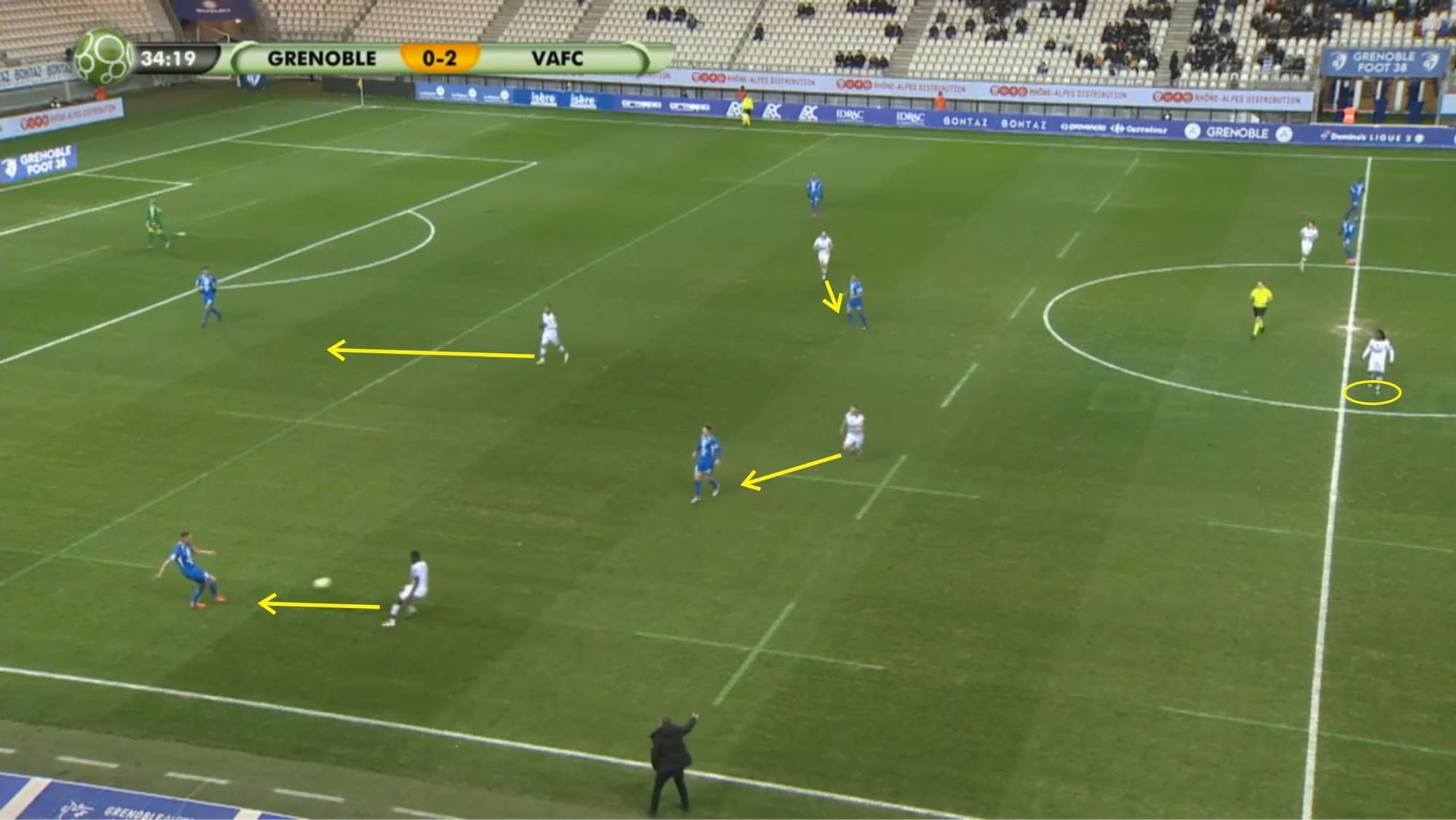
Some other times, the wing-back will push forward and press the ball carrier on the flank rather than the striker. In the situation above, for example, left wing-back Aly Abeid left his spot and pushed far forward in order to press the ball carrier. In this particular situation, the left centre-back would cover his spot and mark the opposing right-winger. As you can see, Valenciennes used a mix of man and space-oriented approach.
The left central midfielder marked the near option and would immediately press when he saw the ball played towards his man. Meanwhile, the ball-near striker positioned himself not very tight but also not very far from the ball-near opposing centre-back so he could quickly press him or potentially intercept the pass towards him if the ball was played back. Furthermore, you can also see the ball-far striker moved to mark the opposing defensive midfielder. The Valenciennes defensive midfielder (yellow circle) was free from any marking duty in this situation and would defend the space instead of picking up a man to mark.
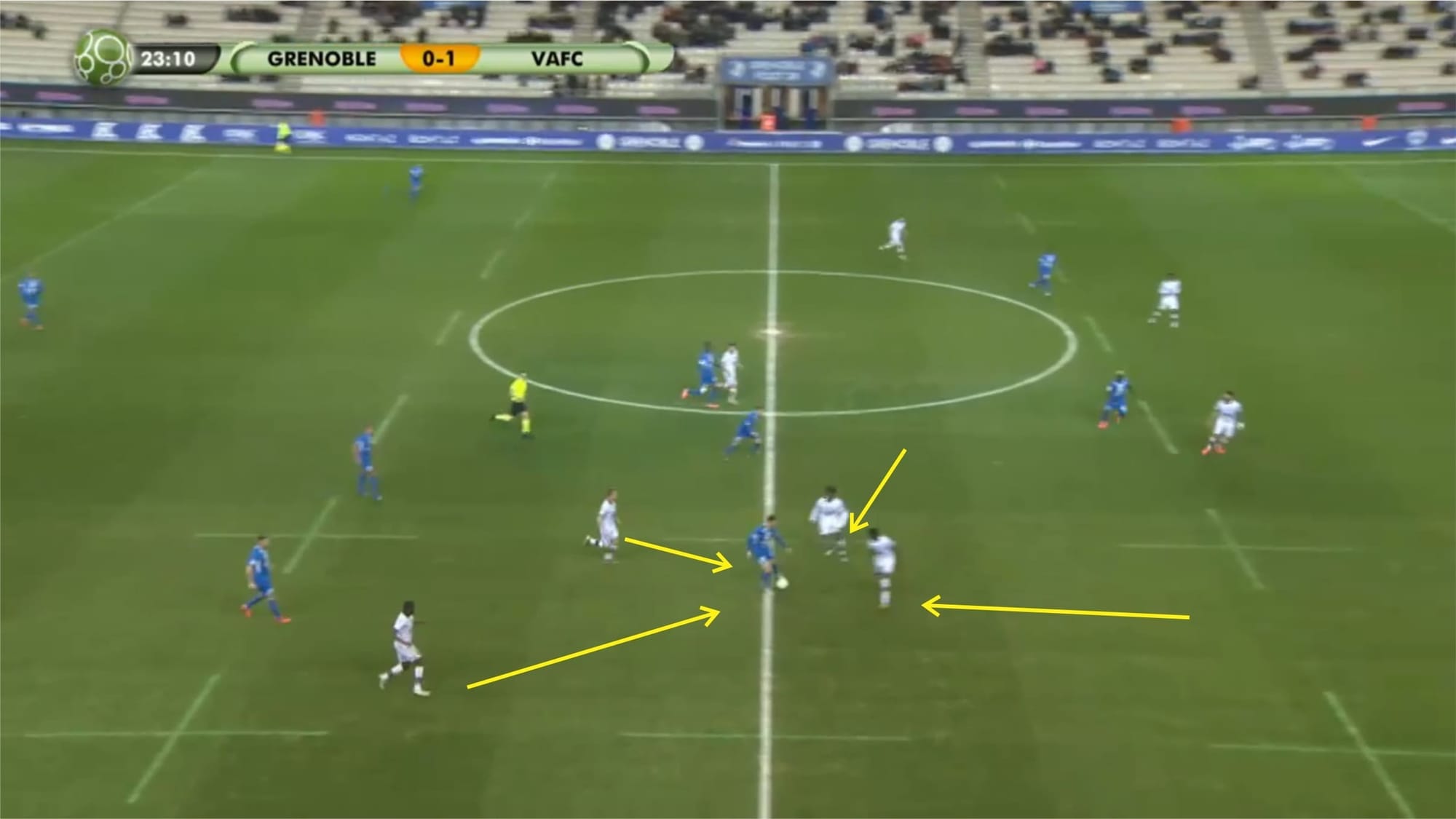
As mentioned before, Valenciennes don’t press aggressively inside the opposing team’s half, but rather they would force the opposing team to move the ball wide before overloading that area and trapping them there. Guégan’s side, however, don’t only press the opposing team in wide areas. But they also set up pressing traps in central areas and half-spaces in the middle third between the forward and midfield lines or midfield and defensive lines. If the opposing team manage to work their way into the middle third and into Valenciennes’ mid-block, they will be immediately swarmed by multiple Valenciennes players.
Valenciennes would try to immediately compress space if an opposing player drives into or receives the ball in between the lines inside their mid-block. As you can see above, the nearest players would jump out of position to press the opposing ball carrier. They would essentially cut off the ball carrier’s passing lanes and press him, giving him no room to breathe and very limited options on the ball.
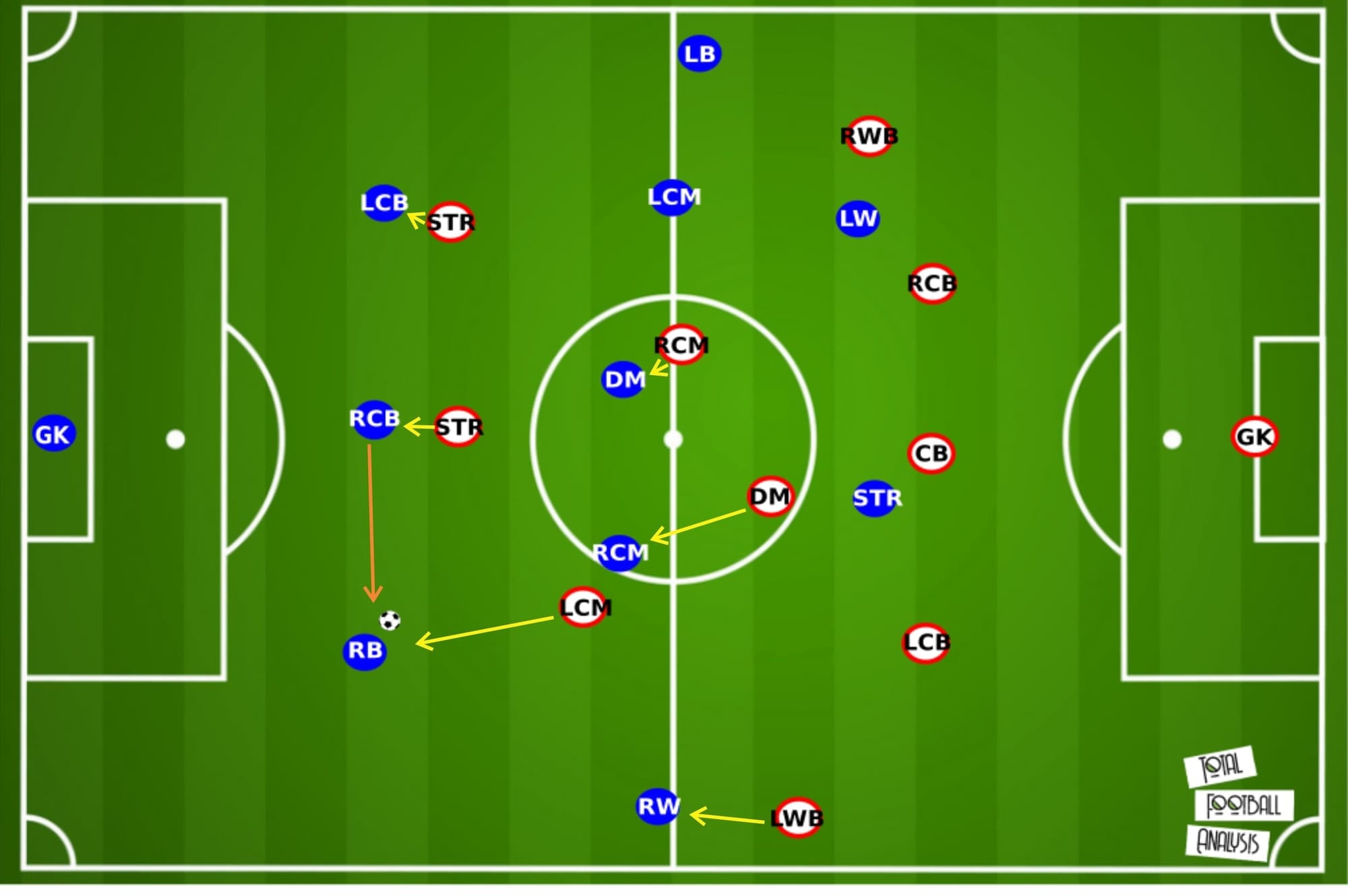
Sometimes the opposing team may create a back-three in the build-up perhaps by having one of the full-backs stay deep or having the defensive midfielder drop back and sit in between or beside the two centre-backs. If Valenciennes play with a front-two, they may become outnumbered upfront. Due to that, usually the nearest central midfielder will then push forward to press the right or left-sided player of the opposing back three as you can see in the image above.
In the image above, the opposing middle centre-back plays the ball towards the right-back. Valenciennes’ left central midfielder will then push forward and press the ball receiver while staying in line with his passing lane to the opposing right central midfielder. Valenciennes’ defensive midfielder will also push forward and mark the opposing right central midfielder, preventing a pass to be played to him. As you can see, the two Valenciennes striker would close down the lateral passing options as well, further limiting the opposing right-back’s passing options. In this case, the opposing right-back may play the ball towards the right-winger but they will immediately be met by Valenciennes’ press and overload on the flank. He may also play the ball long or play the ball back to the goalkeeper.
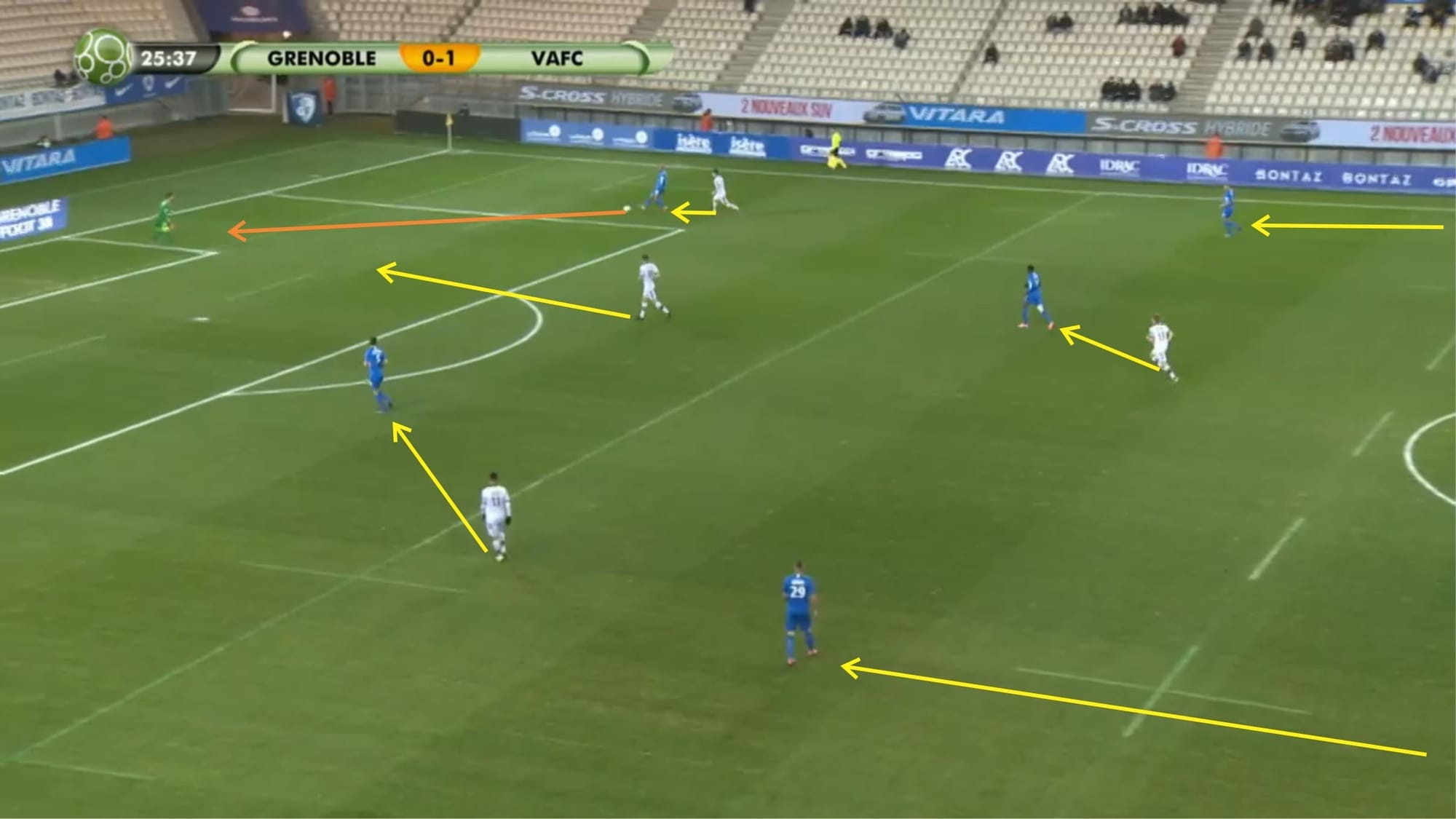
Although Valenciennes usually don’t press the opposing team aggressively in the final third, certain situations may trigger them to push forward and pile pressure into the opposing backline. A poor backward pass towards an opposing defender causing the receiver to control in an uncomfortable manner may immediately trigger Valenciennes’ press upfield. Or like in the image above, if the near options are all blocked/marked and the ball carrier decides to pass the ball back to the goalkeeper, Valenciennes would also push forward and press.
As you can see in the image above, the opposing ball carrier couldn’t find a good passing option near him and decided to turn around to pass the ball back to the goalkeeper. The ball carrier’s turn prompted the ball-near striker to press him and force him to make the backpass. The ball carrier then passed the ball back to the goalkeeper which was met with pressure from another Valenciennes striker.
Inside the opposing team’s half, Valenciennes were man-oriented to prevent a pass towards the nearby options. The wing-backs (both not in the frame) would also push forward in order to mark the opposing teams’ full-backs.
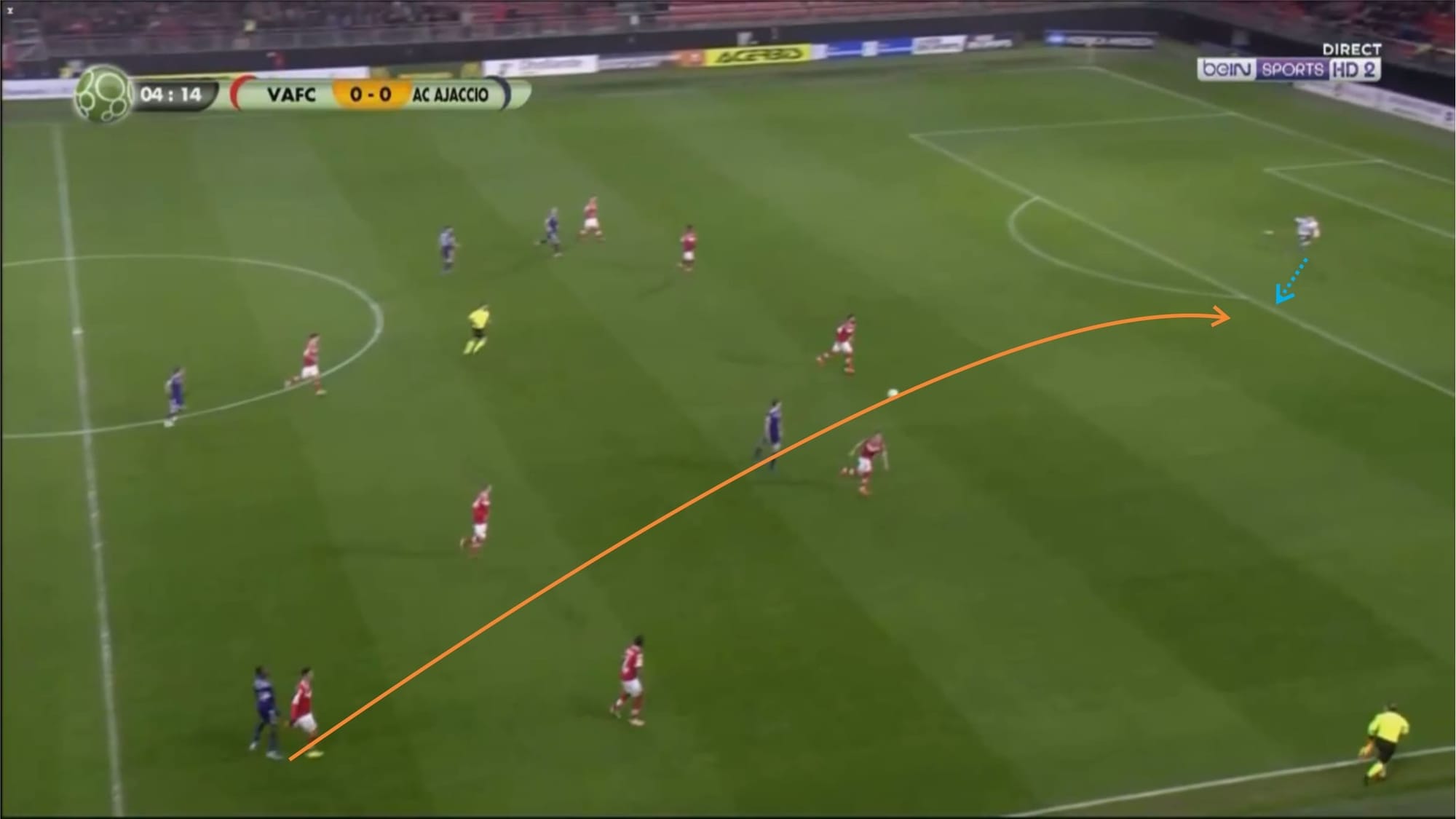
Another way that an opposing team might try to bypass Valenciennes’ defence is by playing long balls. Firstly, Valenciennes’ backline are is usually neither very high nor very low. They’ll also adjust the height depending on the midfield line. If the midfielders are going up to press, then the backline would also push forward in order to keep the shape compact and prevent gaps between defence and midfield. So, usually there’s not much space available in front of the defence, but there may be a bit of space behind the defence. However, goalkeeper Prior is usually always ready to deal with through passes or looses balls into the back of the defence. The goalkeeper who used to play for Bordeaux in Ligue 1 is quick to react, quick to move across the ground and has good anticipation as well as decision making.
Sitting back in own half
As mentioned in this analysis, Valenciennes tend to prevent the opposing team from progressing and attacking centrally with their narrow and compact shape. Furthermore, they will look to force them to play through the wide areas and wide channels instead. Due to their structure, forcing to play through the middle against them would be a very difficult route to go through and would not be an ideal option in attack. However, the flanks are usually quite open and can often be exploited quite easily by the opposing team if they manage to break through Valenciennes’ pressing traps in the middle third.
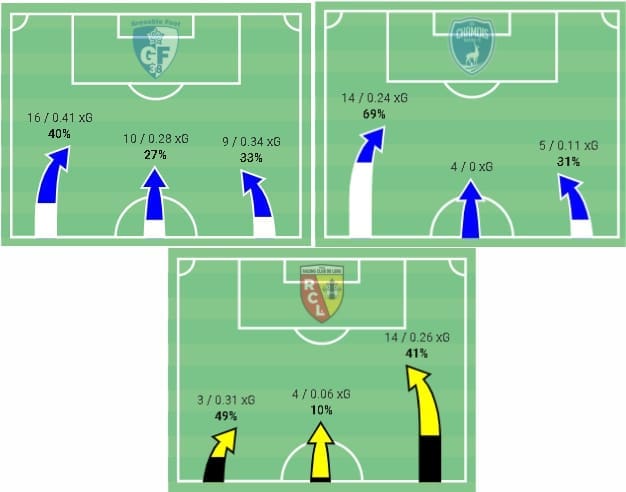
As you can see in the images above, against Valenciennes, the opposing teams tend to attack through the flanks rather than centrally. Quite a lot of chances are also created through crosses. Valenciennes face an average of 16 crosses per game this season and around 33.4% of them are accurate.
If an opposing successfully broke through Valenciennes’ pressing traps in the middle third and enter their defensive third, the whole team would usually try to quickly recover their shape and sit back to defend the box.
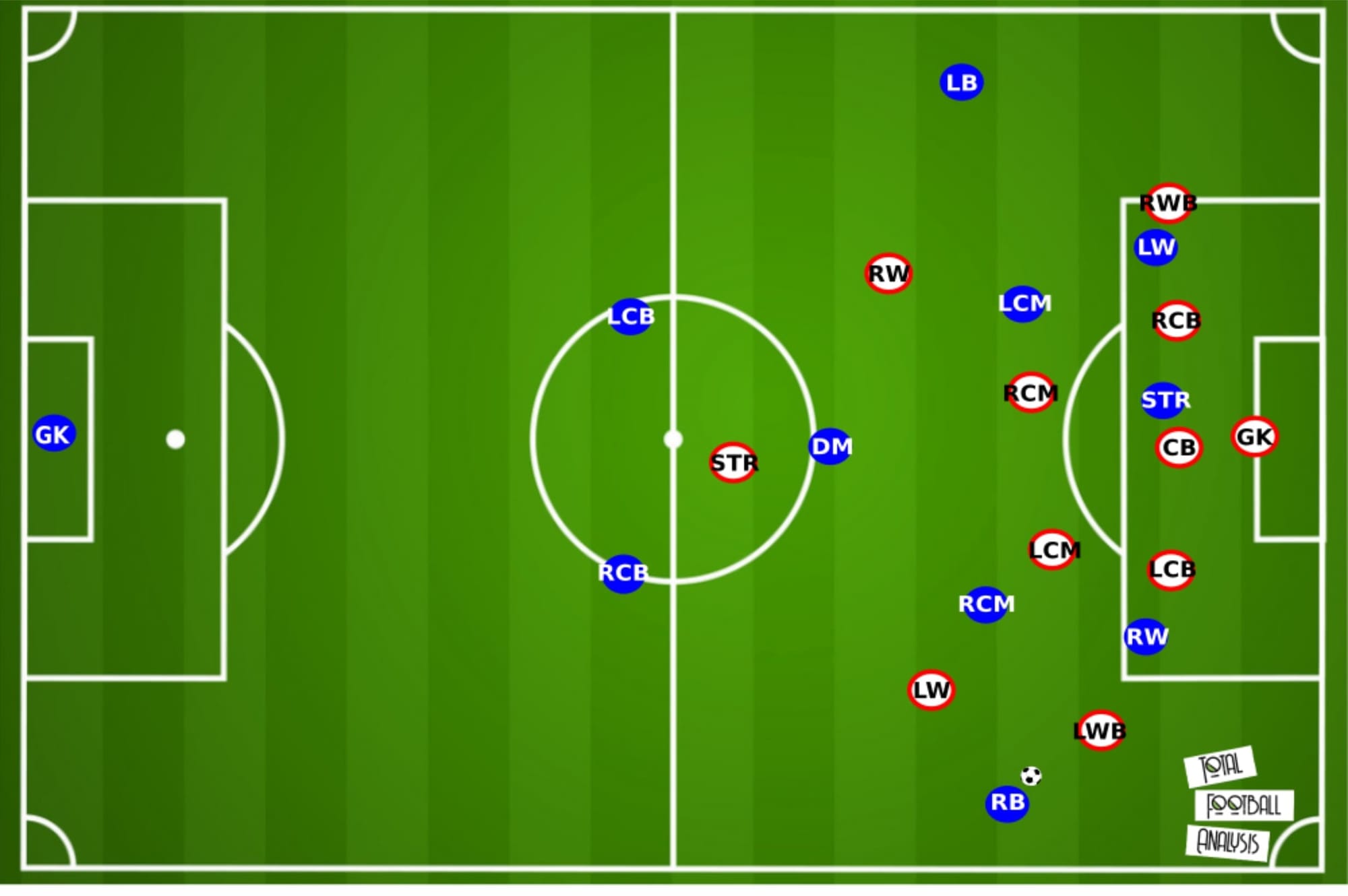
Above you can see their structure when defending the box. The three centre-backs, as well as, the ball-far wing-back would sit inside the box and spread across the goal rather than swarming one particular area. The ball-near wing-back sometimes may be left in a 1v1 situation against an opposing wide player but may also receive help from the ball-near winger. There are usually at least one or two players waiting at the edge of the box to anticipate layoffs or spillouts. Meanwhile, the ball-far winger and the striker usually stay quite high up the pitch for rest offence.
Counter-pressing
Valenciennes are generally not very aggressive and intense in counter-pressing. They’d usually have one or two nearest players press the ball carrier while others mark the nearby options which you can see in the illustration below.
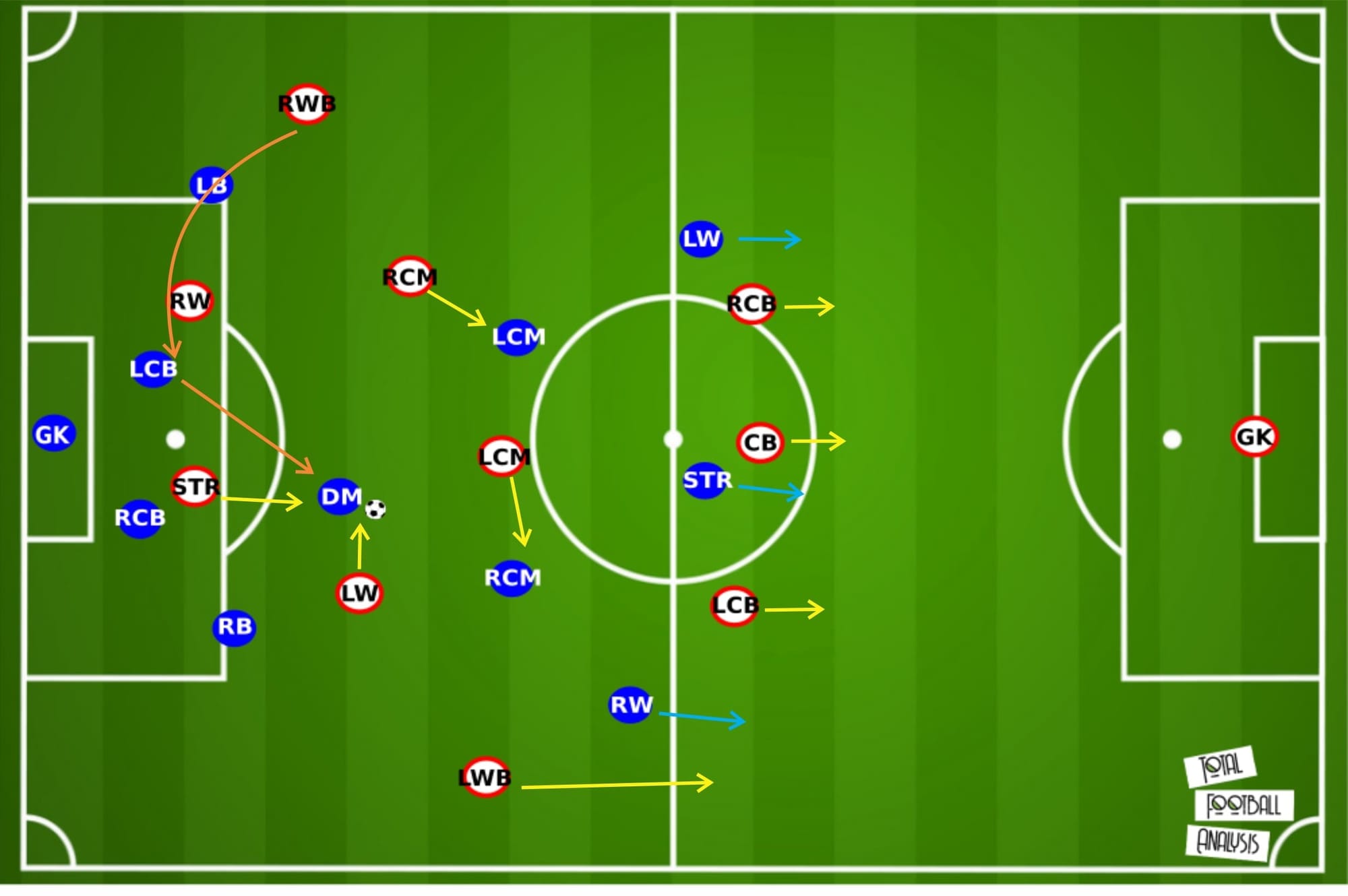
As you can see in the image above, Valenciennes (now in a 3-4-3 formation) have two players pressing the ball carrier while the other ball-near players will pick a man each to mark. The ball-far players, meanwhile, seem to be more space-oriented rather than man-oriented. They’ll protect their own area but will also watch out for opposing players’ runs in behind. Their main goal in counter-pressing is not really to recover the ball upfield and break quickly once again, but they’ll mainly look to delay the opposing team’s counter-attack to allow the rest of the team to recover their shape and set-up their defence.
Weaknesses
Although Valenciennes have been very good at preventing central progressions and attacks, there are several ways a team can do to open up central spaces and exploit them centrally.
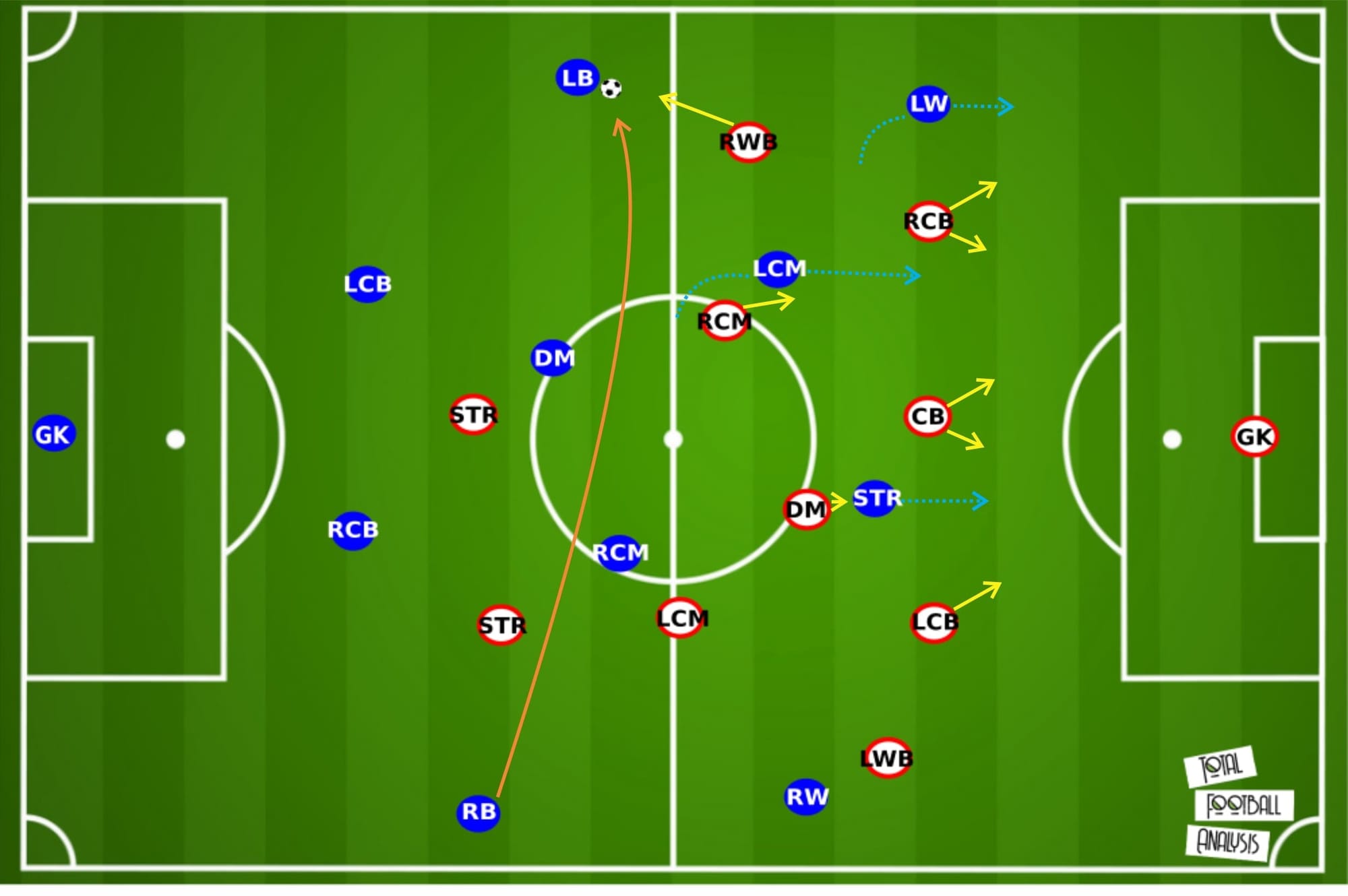
Firstly, it seems rather easy to open up vertical channels by switching play often against Valenciennes. By playing the ball laterally and moving the ball from one side to another, the opposing team may create vertical gaps between Valenciennes players like in the image above.
If the ball is moved towards the other side of the flank like in the image above, Valenciennes will try to quickly move the block and overload the other side of the pitch. As you can see in the image above, the right wing-back would press the opposing left-back in this situation as he’s the closest man to the ball receiver. The left centre-back will then cover the space left by the wing-back and track the run of the opposing left-winger. The left centre-back and the middle centre-back can be separated which may create a gap that can be exploited by the opposing left central midfielder. The ball carrier may also play the ball onto the path of his left-winger which could create a 1v1 situation against Valenciennes’ left centre-back on the flank.
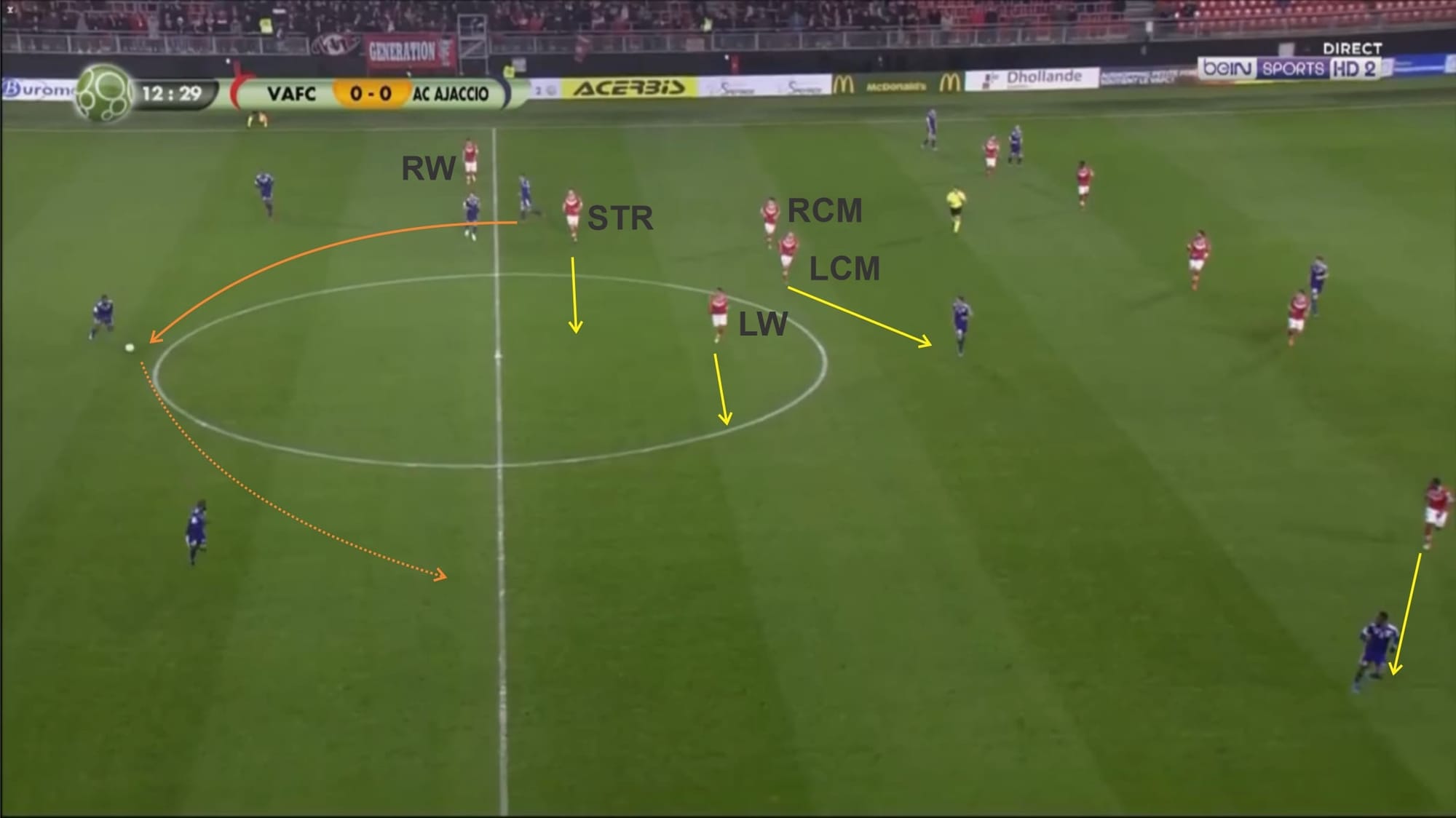
By switching play, an opposing team can also afford much more space and exploit the underloaded area much more comfortably. In the image above, for example, Valenciennes managed to overload the flank and prevented Ajaccio from progressing the ball and entering their defensive third. However, Ajaccio then moved the ball back and then switched the play towards the other side. Valenciennes (in a 3-4-3 formation in this match) committed most of their players towards one side of the pitch so as you can see, the other side is underloaded and once the ball is moved to the other flank, they have an abundance of space. It’s much more effective to be patient and move the ball back and then switch the play against Valenciennes rather than being direct and looking to force a way through their block.
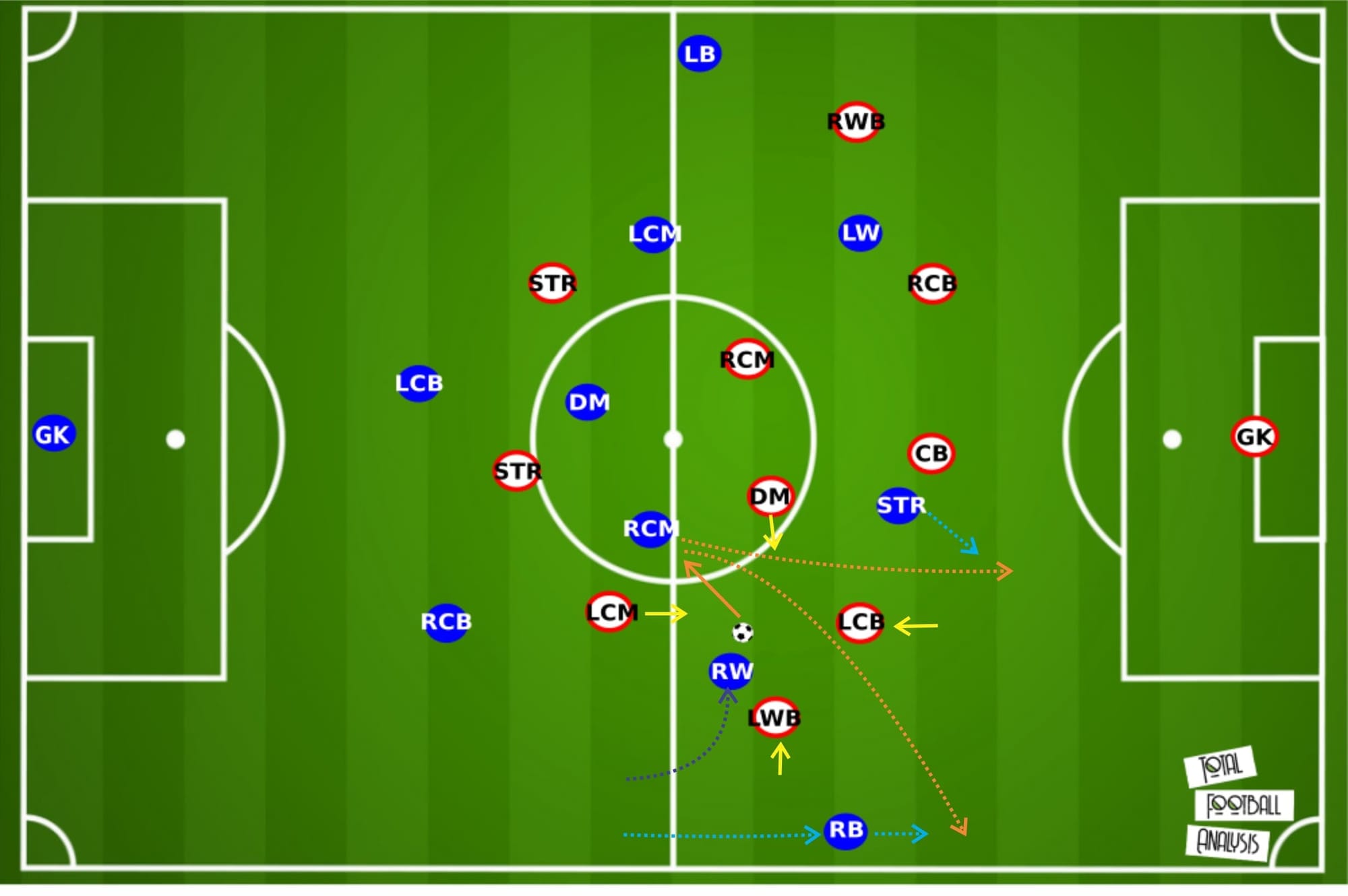
Another visible tendency of theirs that can be exploited is their tendency to trigger their pressing trap and compress space if an opponent manage to find some space in a pocket of space between the lines. Though this is a good way to win the ball back in the middle third if executed flawlessly, they may still be vulnerable to potentially dangerous attack from the opposing team as some players will leave their position in order to swarm the ball carrier.
In the image above, for example, the left wing-back follows and presses the opposing right-winger rather than tracking the run of the opposing right-back. The left centre-back of Valenciennes usually will also jump to press the player in between the lines. In this particular situation, the opposing right-winger manages to squeeze a pass to the right central midfielder who has the chance to play a through pass towards the right-back (who’s completely unmarked) in the flanks or onto the path of the striker who’s being followed by the middle centre-back but can potentially still take a shot from a good position in the centre of the box.
Conclusion
Valenciennes have conceded the least number of goals this season. They’re actually decently solid in defence but that doesn’t mean that they don’t have weaknesses in defence that can be exploited. Their ability to prevent central progressions and attacks and limit the opposing team to attack through the flanks are very good. Most teams are unable to create dangerous chances through combinations from central areas but crosses can come in rather easily.
Guégan’s side seem to allow quite a lot of penalty entries and a lot of chances and shots inside the box for the opposing team, hence the high number of shots against them (12.78 shots faced per game, highest in the league) and highest amount of xG allowed (30.86 in total). Most of the chances and the goals conceded by them are from crosses in wide areas.
What’s interesting is that goalkeeper Prior has faced the third-most shots on target in the league (116 shots from 27 games or 4.3 on average per game) but he still manages to be the goalkeeper with the highest save percentage in Ligue 2 with a save percentage of 86.2% which is impressively high. That perhaps answers a part of the question but that doesn’t necessarily mean that the goalkeeper is doing all the work for them. There are certainly still a few exploitable flaws in Valenciennes’ defence but they can be very solid and extremely difficult to break at times and they have also successfully maintained their solidity throughout the season.





Comments